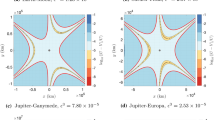Abstract
Lunar perturbations of the Earth’s artificial satellites with large semi-major axis are investigated. Long-term evolution of the orbits are studied through double averaging of the perturbing function. A first order secular solution is derived from Lagrange’s planetary equations. Types of perturbations are discussed and secular resonances between the perturbed orbits of the satellites and the Moon are shown.
Access this chapter
Tax calculation will be finalised at checkout
Purchases are for personal use only
Preview
Unable to display preview. Download preview PDF.
Similar content being viewed by others
References
Cook, G. E. (1972) Basic theory for PROD, a program for computing the development of satellite orbits, Celestial Mechanics 7, 301–314.
Roth, E. A. (1973) Fast computation of high eccentricity orbits by the stroboscopic method, Celestial Mechanics 8, 245–249.
Giacaglia, G. E. O. (1974) Lunar perturbations of artificial satellites of the Earth, Celestial Mechanics 9, 239–267.
Janin, G. (1974) Accurate computation of highly eccentric satellite orbits, Celestial Mechanics 10, 451–467.
Lane. M. T. (1989) On analytic modeling of lunar perturbations of artificial satellites of the Earth, Celestial Mechanics 46, 287–305.
Zare, K., Szebehely, V., and Liu, J. J. F. (1996) A set of regular and uniform elements for satellites of high eccentricity and multiday period, Spaceflight Mechanics 93, 589–599.
Szebehely, V. and Zare, K. (1997) Regions of chaoticity of multi-day satellite orbits, NATO ASI Aquafredda di Maratea.
Kozai Y. (1973) A new method to compute lunisolar perturbations in satellite motions, SAO Special Report 349.
Plummer, H. C. (1918) An Introductory Treatise on Dynamical Astronomy, Cambridge University Press.
Kaula, W. M. (1966) Theory of Satellite Geodesy, Blaisdell Publishing Co.
Author information
Authors and Affiliations
Editor information
Editors and Affiliations
Rights and permissions
Copyright information
© 1999 Springer Science+Business Media Dordrecht
About this chapter
Cite this chapter
Érdi, B. (1999). Dynamics of Satellites with Multi-Day Periods. In: Steves, B.A., Roy, A.E. (eds) The Dynamics of Small Bodies in the Solar System. NATO ASI Series, vol 522. Springer, Dordrecht. https://doi.org/10.1007/978-94-015-9221-5_29
Download citation
DOI: https://doi.org/10.1007/978-94-015-9221-5_29
Publisher Name: Springer, Dordrecht
Print ISBN: 978-90-481-5133-2
Online ISBN: 978-94-015-9221-5
eBook Packages: Springer Book Archive




